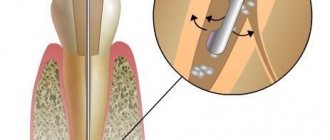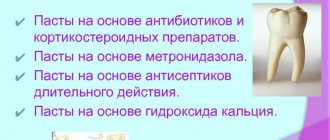The method of treating dental canals with resorcinol-formalin paste, proposed at the beginning of the last century in Germany, lasted more than 100 years. The effect of the paste is based on its mummifying and bactericidal effect on the affected dental pulp.
Due to this paste, the process of inflammation in the pulp stopped, and the paste firmly hardened and sealed the canal. It would seem that everything is fine, the pulp ceases to exist, the canal is closed.
But as it turned out, the use of resorcinol and formaldehyde in dentistry is categorically unacceptable.
Resorcinol-formalin method of root canal filling
This method involves the transformation of the pulp or its decay in the impassable part of the root canal into a plastic-like aseptic strand that is not subject to dissolution or decay under the influence of microflora and tissue fluid.
First, the carious cavity is prepared, the tooth cavity is opened and endodontic access is created. After this, the patency of the root canals is determined. Well-passable canals are mechanically and medicinally treated and sealed.
Pregnation with a resorcinol-formalin mixture is carried out in three to four visits. When carrying out the resorcinol-formaldehyde method, the contents of the root canal are impregnated with a resorcinol-formaldehyde mixture, which, after using a catalyst, polymerizes into phenol-formaldehyde plastic. As a result, the pulp, together with microorganisms, appears to be immured in this glass-like mass that does not decay. During the polymerization process, this mass shrinks, moving away from the canal walls and apical foramen, so the resorcinol-formalin method does not guarantee sealing of the canal lumen. To reduce shrinkage, the passable part of the canal should be filled with resorcinol-formalin paste.
After the resorcinol-formalin method, the tooth turns pink; when it penetrates the apical foramen, the resorcinol-formalin mixture causes irritation of periodontal tissue.
Resorcinol and formaldehyde are hazardous to health
Resorcinol and formaldehyde have toxic and carcinogenic properties.
Penetrating from the dental canal into the blood, formaldehyde enters vital organ systems and negatively affects them. There is evidence that under its influence irreversible consequences can occur, including the development of oncology. In almost all countries of the world, this method has been prohibited for use for more than half a century. In our country, during Soviet times, it was used in the treatment of chewing teeth.
(molars)
in 84% of cases
, and continues to be used now by some careless dentists, especially in budgetary organizations, symbolizing poor quality treatment in professional circles.
Silver plating method for root canal filling
The silvering method involves soaking the impassable part of the root canal with silver nitrate. After the restoration of silver, a thin film of metallic silver (“silver mirror reaction”) is deposited on the walls of the micro- and macrochannels, “burying” the microflora in the thickness of the dentin. As a result of the interaction of silver with pulp proteins, silver albuminates are formed, which “preserve” the pulp, turning it into an aseptic strand that is not subject to putrefactive decay. In addition, the presence of silver in the canal, which has a long-term antiseptic (more precisely, oligodynamic) effect, prevents the growth of microflora and the development of inflammatory complications from the apical periodontium.
Impregnation using the silvering method is also carried out in 3-4 visits.
Arsenic
How the nerve was removed before: they drilled a hole in the tooth, put arsenic paste into it, and then installed a temporary filling.
Within 1-3 days the nerve “died” and you came back for an appointment again. The dentist removed the nerve and filled the tooth. But time does not stand still - less dangerous drugs have been invented for painless removal of nerves. Why don't we use arsenic? Because this is not only an outdated treatment method, but also dangerous.
Arsenic is the strongest poison. That's why it has no place in the mouth at all. It has a detrimental effect on both teeth and surrounding tissues. Here are just some of the possible consequences:
- swelling of the gums;
- blackening of the tooth;
- inflammation of the connective tissue near the diseased tooth;
- necrosis (death) of bone or periosteum;
- periodontitis;
- intoxication.
Moreover, in most developed countries, arsenic is PROHIBITED for use in children and pregnant women.
Combination of silvering method and resorcinol-formalin method
To increase the efficiency and reliability of impregnation methods, it was proposed to combine the silver plating method and the resorcinol-formalin method. In this case, the silvering method is first carried out, in which the walls of the micro- and macro-channels are covered with a film of metallic silver. Then impregnation is carried out with a resorcinol-formalin mixture, as a result of which the pulp in the impassable part of the root canal turns into an aseptic plastic-like strand that is not subject to dissolution or decay under the influence of microflora and tissue fluid.
Indications and contraindications for root canal filling
Indications:
- The presence of pain, signs of gum inflammation, and swelling in a patient who has recently undergone endodontic treatment.
- Low quality filling material.
- Depressurization of the seal or insufficient seal at the edges. In this case, food will get under the filling, rot there and provoke the development of caries.
- Inflammation or infection of the dental canals under the filling.
- The need for repeated treatment of root canals for pulpitis, periodontitis, cysts or granulomas.
- The need to implant an artificial tooth root.
- Failure to comply with the previously performed root canal obturation technology.
Contraindications:
- Unsuitability of the tooth for reconstruction.
- Significant damage to periodontitis, but the ability to save the tooth.
- Inability to intervene in the tooth on its closed part.
- The presence of a malignant neoplasm in the area of the diseased tooth.
- Purulent-necrotic in bone tissue.
- The patient's poor health condition.
Mummification of the contents of the impassable part of the root canal
The term “mummification” in dentistry refers to the prevention of microbial decomposition of the pulp by impregnating it with potent antiseptics (thymol, camphor, iodoform, cresol, parachlorophenol, etc.). For this purpose, a cotton swab moistened with potent, slowly dissolving antiseptics, or a paste containing mummifying substances, is placed into the tooth cavity at the mouth of the root canals, and the tooth is sealed. This method is currently practically not used due to its low efficiency.
Poisons and carcinogens used in dentistry
Residents of our country who have visited Japan or South Korea at least once know: there is completely different food, clothing, cosmetics, medicine - all this is very different from what we are used to.
Why is this happening? The fact is that each country has its own quality standards. We call them GOSTs.
And in Russia, and in America, and in Europe there are such concepts as permissible dose of radiation and permissible concentration of toxic substances. Moreover, in each country these indicators are different and very different.
For example, at the state level we are allowed to use carcinogens, mutagens, and various E-shocks. In our country, unfortunately, they are used even in baby food for infants. And any Russian for you
Simple examples of some E-sheks approved for use in Russia, which you and I eat every day: - E-210 Benzoic acid - causes asthma attacks; - E-220 Sulfur dioxide, E-221 Sodium sulfate, E-261 Potassium acetate - cause kidney problems; — E-235 Nitamycin (pimaricin) – causes allergic reactions, nausea and diarrhea; — E-249 Potassium nitrate is a possible carcinogen...
Unfortunately, this list can be continued for a very long time.
In Europe, at least it is possible to avoid the use of E-shek in products for infants. Here, baby food is preserved with vitamin C. Although in almost all EU countries, albeit to a lesser extent, toxic substances are still used in food and cosmetics.
But in Japan, whose residents were once frightened by the events in Hiroshima and Nagasaki, there is not even such a thing as an acceptable dose of radiation or toxins. The production of food, cosmetics and medicines is very strictly monitored here. It’s not for nothing that Japanese drugs are valued all over the world.
In this regard, South Korea is very similar to Japan. Therefore, when I visit Seoul for work, I always buy vitamins for my family there. Yes, they are 10 or even 20 times (!) more expensive than Russian ones. But I know that they are 100 times (!!!) better quality than our drugs, and therefore I am ready to pay for it.
It's no secret that the use of toxic substances in food, medicines and cosmetics has a very strong impact on health. But their action is not lightning fast; they are slow-acting poisons. And people have the illusion that these toxins “are not so harmful.”
But if you think about the statistics below, it becomes creepy: - In Japan, out of 127 million people, there are more than 50,000 centenarians who are over 100 years old. — In Russia, out of 145 million people, only 4,500 are centenarians!
In our country, the number of people who have survived the 100-year mark is almost 12 times less than in Japan! Isn’t this an indicator of the general health of the nation, which is constantly fed with preservatives and carcinogens?
And it's not just about nutrition...
The materials used in domestic dentistry play an important role here.
One of these drugs that simply terrifies European dentists is resorcinol formaldehyde. All over the world it is called “Red Russian cement” .
Why Russian? Because it is not used anywhere in the world except Russia. This is a real shame for Russian dentistry. Why Red? Because after using this drug, the teeth become red.
Resorcinol formalin has been the leading material in Russian endodontics for 20 years. In Russia they “almost” abandoned it only about 10 years ago.
Many years ago, it was strictly prohibited in most countries. It has been scientifically proven that this is a harmful drug that causes carcinogenic and mutagenic effects.
How can you put something in a tooth knowing that it can lead to cancer? Moreover, today even in Russia there are no longer doctors who do not know about this.
And logically, when putting this drug into a patient’s tooth, the doctor should say that “this tooth can be saved for some time, but you will be predisposed to cancer, and with a very high probability.”
And resorcinol formalin is not the only poison “allowed” in domestic dentistry.
Another category of drugs banned in Europe, but used in Russia, are “devitalizers” based on arsenic.
Unfortunately, many even young Russian specialists simply cannot imagine dentistry without arsenic. And when I urge doctors in my courses to abandon this toxic substance, they timidly ask: “But if it is used correctly, it will not cause much harm...?”
All Russian medical universities must cover the topic “How to use arsenic correctly.” It is placed on a single-rooted tooth for 24 hours. If the tooth has a lot of root problems, then an arsenic-based drug is applied for 48 hours.
That is, according to this logic, in one day arsenic should reach the top of a single-rooted tooth, kill the entire nerve, and it will not go further into the human body. In a multi-rooted tooth, arsenic, in theory, should reach the apex in all roots within 48 hours, and stop there.
But such reasoning is very stupid.
Scientific studies were conducted on laboratory animals in which arsenic was placed in the teeth. Within 2 hours, traces of arsenic were found in the heart, kidneys, liver and other organs.
That is, in other words, the poison strikes the entire body. Yes, the dose of poison that is placed on the tooth is small, the patient will not develop cirrhosis of the liver, he will not have kidney failure, his brain will work as usual.
Nevertheless, some amount of poison will still remain in the body. And as we understand, with each nerve killed with arsenic, this proportion increases.
This is exactly the “allowed amount of a toxic substance for use.”
But why has arsenic been used in dentistry for centuries? Why not use the same potassium cyanide, because it is much more effective?
For one simple reason: for tooth depulpation, the dosage of potassium cyanide is much more difficult to calculate. It’s just that a doctor, instead of a nerve, will most likely poison the whole person. But the principle of action of arsenic is the same - it is poison.
Of course, we understand that arsenic is much safer than potassium cyanide, but nevertheless it remains a poison!
Indeed, many years ago, it was impossible to kill a nerve without arsenic. Therefore, its use in those distant times was at least somehow justified. But not today!
Until now, a huge number of arsenic-based drugs are produced in the world. And they are used by dentists in third world countries, unfortunately also in Russia.
The purpose of using such drugs is clear: the doctor wants to kill the tissues that he needs to remove. But, I repeat, arsenic kills not only those tissues that are necessary, but also affects the entire body.
Of course, in modern dentistry you will not see a box in the dentist’s office with the inscription “Arsenic”. These will be branded beautiful preparations made on the basis of arsenic paste. And this misleads many patients and even doctors, who justify themselves by saying: “But these are European materials: French, German, and so on. But in these countries they don’t do nonsense.”
France is most often cited. They produce a huge number of arsenic-based and formaldehyde-based drugs.
But do not forget that there are drugs produced in Europe that are produced only for third countries. Yes, they are produced in Germany and France, but their use is prohibited in Europe!
There are also American drugs that are prohibited for use in the USA and Canada.
In fairness, it is worth noting that the use of the same resorcinol formaldehyde in Russian dentistry is also not encouraged.
We have the following formulation: “The Russian Dental Association does not recommend the use of formalin resorcinol.” But what does “does not recommend” mean?
All dentists understand perfectly well that if it is not officially prohibited, then it is allowed.
For example, I do not recommend driving a Lada-Kalina, but I recommend driving a Mercedes. But this is not necessary for everyone.
Also with resorcinol formaldehyde. If it is not prohibited, then it is used. This method is considered cheap, easy to use, and can actually save a tooth for a while. But in fact, by saving one tooth, the dentist exposes the patient to a very strong predisposition to cancer.
Knowing all this, many Russian doctors continue to use resorcinol, formalin and arsenic, and at the same time proudly declare that with the help of these drugs they “save teeth”... And this is really scary.
Russian dental statistics are simply terrifying. The most popular material for filling root canals in Russia is Endomethasone. Every single dentist knows that this is a very harmful drug containing paraformaldehyde and steroids. It is banned in many countries around the world. Companies selling dental materials in Russia say that 80% of clinics buy Endomethasone for canal filling. Why???!!!
Many clinics, according to their doctors and managers, use these poisons “forcibly.” Because it's much cheaper. Patients do not agree to more expensive treatment.
They explain it this way: after all, the neighboring dentistry also offers treatment using arsenic or paraformaldehyde for a very “moderate” fee. And everyone goes there...
But I categorically disagree with this position. Is it possible to risk people's health to make money? Yes, most patients will never know that they received a dose of poison or carcinogen in the dentist's chair. But the doctor himself will know about it!










